Bridge
This article needs additional citations for verification. (July 2022) |

A bridge is a structure built to span a physical obstacle (such as a body of water, valley, road, or railway) without blocking the way underneath. It is constructed for the purpose of providing passage over the obstacle, which is usually something that is otherwise difficult or impossible to cross. There are many different designs of bridges, each serving a particular purpose and applicable to different situations. Designs of bridges vary depending on factors such as the function of the bridge, the nature of the terrain where the bridge is constructed and anchored, the material used to make it, and the funds available to build it.
The earliest bridges were likely made with fallen trees and stepping stones. The Neolithic people built boardwalk bridges across marshland. The Arkadiko Bridge, dating from the 13th century BC, in the Peloponnese is one of the oldest arch bridges still in existence and use.
Etymology
The Oxford English Dictionary traces the origin of the word bridge to an Old English word brycg, of the same meaning.[1][2]: bridge1
The Oxford English Dictionary also notes that there is some suggestion that the word can be traced directly back to Proto-Indo-European *bʰrēw-. However, they also note that "this poses semantic problems."[3]
The origin of the word for the card game of the same name is unknown.[2]: bridge2
History

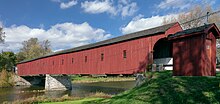


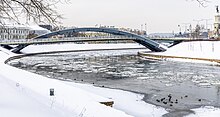
The simplest and earliest types of bridges were stepping stones.
The
The greatest bridge builders of antiquity were the
In
Although large bridges of wooden construction existed in
Rope bridges, a simple type of suspension bridge, were used by the Inca civilization in the Andes mountains of South America, just prior to European colonization in the 16th century.
The
During the 18th century, there were many innovations in the design of timber bridges by
A major breakthrough in bridge technology came with the erection of
In
In 1927,
Types of bridges
Bridges can be categorized in several different ways. Common categories include the type of structural elements used, by what they carry, whether they are fixed or movable, and by the materials used.
Structure types
Bridges may be classified by how the actions of
 Beam bridge Beam bridge
|
Rio–Niteroi Bridge, a box girder bridge, is 300 metres (980 ft).[citation needed ]
The world's longest beam bridge is Lake Pontchartrain Causeway in southern Louisiana in the United States, at 23.83 miles (38.35 km), with individual spans of 56 feet (17 m).[28] Beam bridges are the simplest and oldest type of bridge in use today,[29] and are a popular type.[30] |
 Truss bridge Truss bridge
|
A truss bridge is a bridge whose load-bearing superstructure is composed of a truss. This truss is a structure of connected elements forming triangular units. The connected elements (typically straight) may be stressed from tension, compression, or sometimes both in response to dynamic loads. Truss bridges are one of the oldest types of modern bridges. The basic types of truss bridges shown in this article have simple designs which could be easily analyzed by nineteenth and early twentieth-century engineers. A truss bridge is economical to construct owing to its efficient use of materials. |
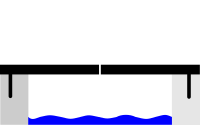 Cantilever bridge Cantilever bridge
|
continuous spans that extend from opposite sides of the supporting piers to meet at the center of the obstacle the bridge crosses. Cantilever bridges are constructed using much the same materials and techniques as beam bridges. The difference comes in the action of the forces through the bridge.
Some cantilever bridges also have a smaller beam connecting the two cantilevers, for extra strength. The largest cantilever bridge is the 549-metre (1,801 ft) Quebec Bridge in Quebec, Canada. |
 Arch bridge Arch bridge
|
abutments at either side. The earliest known arch bridges were built by the Greeks, and include the Arkadiko Bridge .
With the span of 220 metres (720 ft), the Solkan Bridge over the Soča River at Solkan in Slovenia is the second-largest stone bridge in the world and the longest railroad stone bridge. It was completed in 1905. Its arch, which was constructed from over 5,000 tonnes (4,900 long tons; 5,500 short tons) of stone blocks in just 18 days, is the second-largest stone arch in the world, surpassed only by the Friedensbrücke (Syratalviadukt) in Plauen, and the largest railroad stone arch. The arch of the Friedensbrücke, which was built in the same year, has the span of 90 m (295 ft) and crosses the valley of the Syrabach River. The difference between the two is that the Solkan Bridge was built from stone blocks, whereas the Friedensbrücke was built from a mixture of crushed stone and cement mortar.[31] The world's largest arch bridge is the |
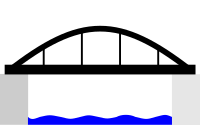 Tied arch bridge Tied arch bridge
|
Tied-arch bridges have an arch-shaped superstructure, but differ from conventional arch bridges. Instead of transferring the weight of the bridge and traffic loads into thrust forces into the abutments, the ends of the arches are restrained by tension in the bottom chord of the structure. They are also called bowstring arches. |
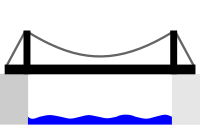 Suspension bridge Suspension bridge
|
suspended-deck suspension bridge, and the self-anchored suspension bridge. There is also what is sometimes called a "semi-suspension" bridge, of which the Ferry Bridge in Burton-upon-Trent is the only one of its kind in Europe.[33]
The longest suspension bridge in the world is the 4,608 m (15,118 ft) 1915 Çanakkale Bridge in Turkey. |
 Cable-stayed bridge Cable-stayed bridge
|
Cable-stayed bridges, like suspension bridges, are held up by cables. However, in a cable-stayed bridge, less cable is required and the towers holding the cables are proportionately higher.[34] The first known cable-stayed bridge was designed in 1784 by C. T. (or C. J.) Löscher.[35][36]
The longest cable-stayed bridge since 2012 is the 1,104 m (3,622 ft) Russky Bridge in Vladivostok, Russia.[37] |
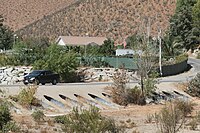 Ford bridge Ford bridge
|
A ford bridge is designed to allow the flow of water over the way. |
Some Engineers sub-divide 'beam' bridges into slab, beam-and-slab and box girder on the basis of their cross-section.[38] A slab can be solid or voided (though this is no longer favored for inspectability reasons) while beam-and-slab consists of concrete or steel girders connected by a concrete slab.[39] A box-girder cross-section consists of a single-cell or multi-cellular box. In recent years, integral bridge construction has also become popular.
Fixed or movable bridges
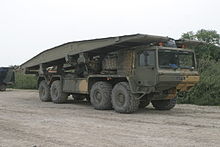
Most bridges are fixed bridges, meaning they have no moving parts and stay in one place until they fail or are demolished. Temporary bridges, such as
The Tank bridge transporter (TBT) has the same cross-country performance as a tank even when fully loaded. It can deploy, drop off and load bridges independently, but it cannot recover them.[citation needed]
Double-decked bridges

Double-decked (or double-decker) bridges have two levels, such as the
Robert Stephenson's High Level Bridge across the River Tyne in Newcastle upon Tyne, completed in 1849, is an early example of a double-decked bridge. The upper level carries a railway, and the lower level is used for road traffic. Other examples include Britannia Bridge over the Menai Strait and Craigavon Bridge in Derry, Northern Ireland. The Oresund Bridge between Copenhagen and Malmö consists of a four-lane highway on the upper level and a pair of railway tracks at the lower level. Tower Bridge in London is different example of a double-decked bridge, with the central section consisting of a low-level bascule span and a high-level footbridge.
Viaducts
A viaduct is made up of multiple bridges connected into one longer structure. The longest and some of the highest bridges are viaducts, such as the Lake Pontchartrain Causeway and Millau Viaduct.
Multi-way bridge
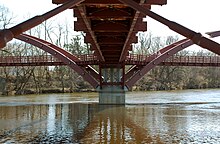
A multi-way bridge has three or more separate spans which meet near the center of the bridge. Multi-way bridges with only three spans appear as a "T" or "Y" when viewed from above. Multi-way bridges are extremely rare. The Tridge, Margaret Bridge, and Zanesville Y-Bridge are examples.
Bridge types by use
A bridge can be categorized by what it is designed to carry, such as trains, pedestrian or road traffic (road bridge), a pipeline (Pipe bridge) or waterway for water transport or barge traffic. An aqueduct is a bridge that carries water, resembling a viaduct, which is a bridge that connects points of equal height. A road-rail bridge carries both road and rail traffic. Overway is a term for a bridge that separates incompatible intersecting traffic, especially road and rail.[43] A bridge can carry overhead power lines as does the Storstrøm Bridge.[citation needed]
Some bridges accommodate other purposes, such as the tower of
Conservationists use wildlife overpasses to reduce habitat fragmentation and animal-vehicle collisions.[45] The first animal bridges sprung up in France in the 1950s, and these types of bridges are now used worldwide to protect both large and small wildlife.[46][47][48]
Bridges are subject to unplanned uses as well. The areas underneath some bridges have become makeshift shelters and homes to homeless people, and the undertimbers of bridges all around the world are spots of prevalent graffiti. Some bridges attract people attempting suicide, and become known as suicide bridges.[49][50]
Bridge types by material
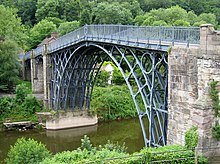
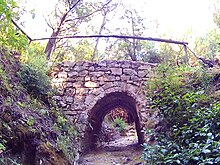
The materials used to build the structure are also used to categorize bridges. Until the end of the 18th century, bridges were made out of timber, stone and masonry. Modern bridges are currently built in concrete, steel, fiber reinforced polymers (FRP), stainless steel or combinations of those materials.
| Bridge type | Materials used |
|---|---|
| Cantilever | For small footbridges, the cantilevers may be simple beams; however, large cantilever bridges designed to handle road or rail traffic use trusses built from structural steel, or box girders built from prestressed concrete.[53] |
| Suspension | The cables are usually made of steel cables galvanised with zinc,[citation needed] along with most of the bridge, but some bridges are still made with steel-reinforced concrete.[54]
|
| Arch | Stone, brick and other such materials that are strong in compression and somewhat so in shear.
|
| Beam | Beam bridges can use pre-stressed concrete, an inexpensive building material, which is then embedded with rebar. The resulting bridge can resist both compression and tension forces.[55] |
| Truss | The triangular pieces of truss bridges are manufactured from straight and steel bars, according to the truss bridge designs.[56] |
Analysis and design
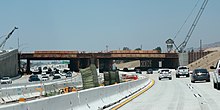
Unlike buildings whose design is led by architects, bridges are usually designed by engineers. This follows from the importance of the engineering requirements; namely spanning the obstacle and having the durability to survive, with minimal maintenance, in an aggressive outdoor environment.[39] Bridges are first analysed; the bending moment and shear force distributions are calculated due to the applied loads. For this, the finite element method is the most popular. The analysis can be one-, two-, or three-dimensional. For the majority of bridges, a two-dimensional plate model (often with stiffening beams) is sufficient or an upstand finite element model.[57] On completion of the analysis, the bridge is designed to resist the applied bending moments and shear forces, section sizes are selected with sufficient capacity to resist the stresses. Many bridges are made of prestressed concrete which has good durability properties, either by pre-tensioning of beams prior to installation or post-tensioning on site.
In most countries, bridges, like other structures, are designed according to Load and Resistance Factor Design (LRFD) principles. In simple terms, this means that the load is factored up by a factor greater than unity, while the resistance or capacity of the structure is factored down, by a factor less than unity. The effect of the factored load (stress, bending moment) should be less than the factored resistance to that effect. Both of these factors allow for uncertainty and are greater when the uncertainty is greater.
Aesthetics

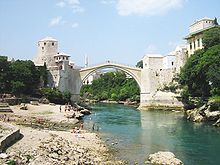
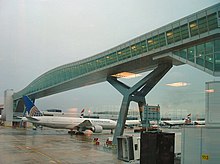
Most bridges are utilitarian in appearance, but in some cases, the appearance of the bridge can have great importance.[58] Often, this is the case with a large bridge that serves as an entrance to a city, or crosses over a main harbor entrance. These are sometimes known as signature bridges. Designers of bridges in parks and along parkways often place more importance on aesthetics, as well. Examples include the stone-faced bridges along the Taconic State Parkway in New York.
Bridges are typically more aesthetically pleasing if they are simple in shape, the deck is thinner in proportion to its span, the lines of the structure are continuous, and the shapes of the structural elements reflect the forces acting on them.[59] To create a beautiful image, some bridges are built much taller than necessary. This type, often found in east-Asian style gardens, is called a Moon bridge, evoking a rising full moon. Other garden bridges may cross only a dry bed of stream-washed pebbles, intended only to convey an impression of a stream. Often in palaces, a bridge will be built over an artificial waterway as symbolic of a passage to an important place or state of mind. A set of five bridges cross a sinuous waterway in an important courtyard of the Forbidden City in Beijing, China. The central bridge was reserved exclusively for the use of the Emperor and Empress, with their attendants.
Bridge maintenance

The estimated life of bridges varies between 25 and 80 years depending on location and material.[60][61]
Bridges may age hundred years with proper maintenance and rehabilitation. Bridge maintenance consisting of a combination of structural health monitoring and testing. This is regulated in country-specific engineer standards and includes an ongoing monitoring every three to six months, a simple test or inspection every two to three years and a major inspection every six to ten years. In Europe, the cost of maintenance is considerable
Bridge traffic loading
While the response of a bridge to the applied loading is well understood, the applied traffic loading itself is still the subject of research.[62] This is a statistical problem as loading is highly variable, particularly for road bridges. Load Effects in bridges (stresses, bending moments) are designed for using the principles of Load and Resistance Factor Design. Before factoring to allow for uncertainty, the load effect is generally considered to be the maximum characteristic value in a specified return period. Notably, in Europe, it is the maximum value expected in 1000 years.
Bridge standards generally include a load model, deemed to represent the characteristic maximum load to be expected in the return period. In the past, these load models were agreed by standard drafting committees of experts but today, this situation is changing. It is now possible to measure the components of bridge traffic load, to weigh trucks, using
Traffic loading on long span bridges
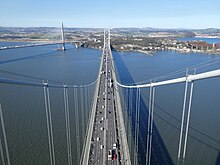
Most bridge standards are only applicable for short and medium spans[72] - for example, the Eurocode is only applicable for loaded lengths up to 200 m. Longer spans are dealt with on a case-by-case basis. It is generally accepted that the intensity of load reduces as span increases because the probability of many trucks being closely spaced and extremely heavy reduces as the number of trucks involved increases. It is also generally assumed that short spans are governed by a small number of trucks traveling at high speed, with an allowance for dynamics. Longer spans on the other hand, are governed by congested traffic and no allowance for dynamics is needed.
Calculating the loading due to congested traffic remains a challenge as there is a paucity of data on inter-vehicle gaps, both within-lane and inter-lane, in congested conditions. Weigh-in-Motion (WIM) systems provide data on inter-vehicle gaps but only operate well in free flowing traffic conditions. Some authors have used cameras to measure gaps and vehicle lengths in jammed situations and have inferred weights from lengths using WIM data.[73] Others have used microsimulation to generate typical clusters of vehicles on the bridge.[74][75][76]
Bridge vibration
Bridges vibrate under load and this contributes, to a greater or lesser extent, to the stresses.[39] Vibration and dynamics are generally more significant for slender structures such as pedestrian bridges and long-span road or rail bridges. One of the most famous examples is the Tacoma Narrows Bridge that collapsed shortly after being constructed due to excessive vibration. More recently, the Millennium Bridge in London vibrated excessively under pedestrian loading and was closed and retrofitted with a system of dampers. For smaller bridges, dynamics is not catastrophic but can contribute an added amplification to the stresses due to static effects. For example, the Eurocode for bridge loading specifies amplifications of between 10% and 70%, depending on the span, the number of traffic lanes and the type of stress (bending moment or shear force).[77]
Vehicle-bridge dynamic interaction
There have been many studies of the dynamic interaction between vehicles and bridges during vehicle crossing events. Fryba[78] did pioneering work on the interaction of a moving load and an Euler-Bernoulli beam. With increased computing power, vehicle-bridge interaction (VBI) models have become ever more sophisticated.[79][80][81][82] The concern is that one of the many natural frequencies associated with the vehicle will resonate with the bridge's first natural frequency.[83] The vehicle-related frequencies include body bounce and axle hop but there are also pseudo-frequencies associated with the vehicle's speed of crossing[84] and there are many frequencies associated with the surface profile.[62] Given the wide variety of heavy vehicles on road bridges, a statistical approach has been suggested, with VBI analyses carried out for many statically extreme loading events.[85]
Bridge failures
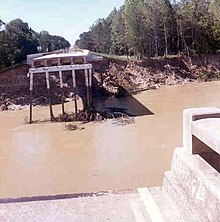
The failure of bridges is of special concern for
The failure of bridges first assumed national interest in Britain during the Victorian era when many new designs were being built, often using new materials, with some of them failing catastrophically.
In the United States, the National Bridge Inventory tracks the structural evaluations of all bridges, including designations such as "structurally deficient" and "functionally obsolete".
Bridge health monitoring
There are several methods used to monitor the condition of large structures, like bridges. Many long-span bridges are now routinely monitored with a range of sensors, including strain transducers,
An option for structural-integrity monitoring is "non-contact monitoring", which uses the
Snapshots in time of the external condition of a bridge can be recorded using Lidar to aid bridge inspection.[90] This can provide measurement of the bridge geometry (to facilitate the building of a computer model) but the accuracy is generally insufficient to measure bridge deflections under load.
While larger modern bridges are routinely monitored electronically, smaller bridges are generally inspected visually by trained inspectors. There is considerable research interest in the challenge of smaller bridges as they are often remote and do not have electrical power on site. Possible solutions are the installation of sensors on a specialist inspection vehicle and the use of its measurements as it drives over the bridge to infer information about the bridge condition.[91][92][93] These vehicles can be equipped with accelerometers, gyrometers, Laser Doppler Vibrometers[94][95] and some even have the capability to apply a resonant force to the road surface in order to dynamically excite the bridge at its resonant frequency.
Visual index
See also
- Air draft
- Architectural engineering
- Bridge chapel
- Bridge tower
- Bridge to nowhere
- Bridges Act
- BS 5400
- Causeway
- Coal trestle
- Covered bridges
- Cross-sea traffic ways
- Culvert
- Deck
- Devil's Bridge
- Footbridge
- Jet bridge
- Landscape architecture
- Megaproject
- Military bridges
- Orphan bridge
- Outline of bridges
- Overpass
- Pier (bridge structure)
- Pontoon bridge
- Rigid-frame bridge
- Structure gauge
- Transporter bridge
- Tensegrity
- Trestle bridge
- Tunnel
References
- ^ Fowler (1925). The Concise Oxford Dictionary. Oxford University Press. p. 102.
- ^ ISBN 0-19-860438-6. Retrieved December 27, 2022.(Full text via the Internet Archive.)(registration required)
- ^ "Bridge: Etymology".
- ^ "South Eighth Street Viaduct, Spanning Little Lehigh Creek at Eighth Street (State Route 2055), Allentown, Lehigh County, PA (HAER No. PA-459)". Historic American Engineering Record. Retrieved January 11, 2021.
- ^ Brunning, Richard (February 2001). "The Somerset Levels". Current Archaeology. XV (4) (172 (Special issue on Wetlands)): 139–143.
- abutments, and over which traffic may pass.
- ISBN 978-0-7277-2774-9. Retrieved March 14, 2010 – via Google books.
- ISBN 978-0-07-161477-1.
- ^ DeLony, Eric (1996). "Context for World Heritage Bridges". Icomos.org. Archived from the original on February 21, 2005.
- ^ "History of Bridges". Historyworld.net. Archived from the original on January 6, 2012. Retrieved January 4, 2012.
- ^ "Lessons from Roman Cement and Concrete". Pubs.asce.org. Archived from the original on February 10, 2005. Retrieved January 4, 2012.
- ISBN 81-208-1023-6.
- ^ ISBN 0-415-23188-4.
- ^ "suspension bridge" in Encyclopædia Britannica (2008). 2008 Encyclopædia Britannica, Inc.
- ISBN 81-7017-159-8.
- ISSN 1452-7448.
- ISBN 9780521379946. Retrieved December 29, 2020 – via Books.google.com.
- ^ ISBN 9781451603736.
- ^ "Iron Bridge". Engineering Timelines. Archived from the original on March 4, 2016. Retrieved November 18, 2016.
- ^ "Gustave Eiffel-15 Iconic Projects". RTF | Rethinking The Future. June 20, 2020. Retrieved June 12, 2021.
- ^ "Historic Wooden Bridges/"Covered Bridges"". HSNB.DE. July 11, 2011. Archived from the original on March 4, 2016. Retrieved October 15, 2018.
- ^ "Hidden Masterpieces: Covered Bridges in PA". Pennsylvania Book Center. Spring 2010. Retrieved October 15, 2018.
- ^ "Throwback Thursday: Covered bridges". Canadian Geographic. May 28, 2015. Retrieved October 15, 2018.
- ^ "Visit America's Most Idyllic Covered Bridges". Architectural Digest. December 2016. Retrieved October 15, 2018.
- ^ Sapp, Mark E. (February 22, 2008). "Welding Timeline 1900–1950". WeldingHistory.org. Archived from the original on August 3, 2008. Retrieved April 29, 2008.
- ^ "Beam bridges". Design Technology. Archived from the original on May 18, 2008. Retrieved May 14, 2008.
- ^ Structural Beam Deflection Stress Bending Equations / Calculation Supported on Both Ends Uniform Loading Archived January 22, 2013, at archive.today. Engineers Edge. Retrieved on April 23, 2013.
- ^ "A big prefabricated bridge". Life. Vol. 40, no. 22. May 28, 1956. pp. 53–60.
- ^ "ASCE | Civil What? | Bridges". www.asceville.org. Archived from the original on February 3, 2017. Retrieved February 2, 2017.
- .
- ISBN 2-85978-347-4. Archivedfrom the original on July 30, 2016.
- ^ "Longest bridge, steel arch bridge". Guinness World Records. Archived from the original on October 19, 2013. Retrieved February 18, 2013.
- ^ A.O.P. Guide to Burton-on-Trent, 1911, p. 13[full citation needed]
- ^ Johnson, Andy. "Cable Stay vs Suspension Bridges". U.S. Department of Energy. Archived from the original on May 18, 2008.
- ISBN 978-0-7277-2773-2. Archivedfrom the original on November 15, 2016.
- ^ Poser, Marcel. "Cable Stayed Structures and Stay Cable Technology" (PDF). Archived from the original (PDF) on February 9, 2013.
- ^ Elder, Miriam (July 2, 2012). "Russian city of Vladivostok unveils record-breaking suspension bridge". The Guardian. London. Archived from the original on January 20, 2016. Retrieved February 3, 2016.
- ^ S2CID 110344262.
- ^ OCLC 892094185.
- .
- ^ a b "Port Authority of New York and New Jersey – George Washington Bridge". The Port Authority of New York and New Jersey. Archived from the original on September 20, 2013. Retrieved February 14, 2023.
- ^ Bod Woodruff; Lana Zak & Stephanie Wash (November 20, 2012). "GW Bridge Painters: Dangerous Job on Top of the World's Busiest Bridge". ABC News. Archived from the original on September 28, 2013. Retrieved September 13, 2013.
- ^ "The Mile-End Crossing". The Observer. Vol. LXXXI, no. 6, 004. South Australia. February 23, 1924. p. 16. Retrieved March 26, 2018 – via National Library of Australia.
- .
- ^ Greenfield, Patrick (January 23, 2021). "How creating wildlife crossings can help reindeer, bears – and even crabs". The Guardian. Archived from the original on January 23, 2021. Retrieved January 26, 2021.
- ^ Sarah Holder (July 31, 2018). "Animals Need Infrastructure Too". Bloomberg.com. Retrieved February 21, 2019.
- ^ Jessica Stewart (February 9, 2017). "Bridges for Animals to Safely Cross Freeways Are Popping Up Around the World". My Modern Met. Retrieved February 21, 2019.
- ^ Rachel Newer (July 23, 2012). "World's Coolest Animal Bridges". Smithsonian.com. Retrieved February 21, 2019.
- PMID 21320739.
- ^ Marsh, Julia (December 30, 2018). "Port Authority not liable for NYC bridge jumpers: judge". New York Post. Retrieved January 3, 2019.
- ^ "How are Living Root Bridges Made?". The Living Root Bridge Project. May 5, 2017. Archived from the original on September 5, 2017. Retrieved September 8, 2017.
- ^ "The Vine Bridges of Iya Valley". Atlas Obscura. Archived from the original on September 8, 2017. Retrieved September 8, 2017.
- ^ "Cantilever". Bridges of Dublin. Archived from the original on October 29, 2014.
- ^ "Suspension Bridges". Made How. Archived from the original on January 2, 2015.
- ^ "Beam Bridges". Nova Online. PBS. Archived from the original on January 6, 2015.
- ^ K, Aggeliki; Stonecypher, Lamar (February 10, 2010). "Truss Bridge Designs". Bright Hub Engineering. Archived from the original on February 19, 2015.
- hdl:10197/4054.
- OCLC 10821288.
- ^ "Bridge Aesthetics. Design guideline to improve the appearance of bridges in NSW" (PDF). February 2009. Archived from the original (PDF) on October 9, 2022.
- ISSN 1084-0702.
- ^ Ford, K.; Arman, M.; Labi, S.; Sinha, K.C.; Thompson, P.D.; Shirole, A.M.; Li, Z. (2012). Estimating life expectancies of highway assets. Washington, DC: Transportation Research Board, National Academy of Sciences. NCHRP Report 713.
- ^ OCLC 897489682.
- S2CID 10042252.
- S2CID 44049002.
- S2CID 53475878.
- ISSN 1822-427X.
- S2CID 59945573.
- ISSN 1478-4637.
- ^ "HL-93 AASHTO Vehicular Live Loading | Truck | Tandem | Design Lane Load". EngineeringCivil.org. August 17, 2016. Retrieved March 15, 2019.
- S2CID 53503763.
- S2CID 111112374.
- ISSN 1573-2487.
- ISSN 1822-4288.
- S2CID 54812838.
- .
- S2CID 56030686.
- OCLC 53389159.
- OCLC 608572498.
- S2CID 53678242.
- S2CID 53057484.
- S2CID 59583241.
- S2CID 53367765.
- S2CID 56078933.
- S2CID 53417698.
- S2CID 52250745.
- ^ "The new Minnesota smart bridge" (PDF). mnme.com. Archived from the original (PDF) on August 23, 2012. Retrieved January 30, 2012.
- ^ Riordon, James R. (December 3, 2022). "Cell phones track bridge integrity". Science News (Paper). Vol. 202, no. 10. p. 8.
- ^ "Basic Principles of Vibrometry". polytec.com. Archived from the original on June 10, 2012. Retrieved January 25, 2012.
- ^ Omer; et al. (2018). "Performance evaluation of bridges using virtual reality". Proceedings of the 6th European Conference on Computational Mechanics (ECCM 6) & 7th European Conference on Computational Fluid Dynamics (ECFD 7), Glasgow, Scotland.
- .
- ISSN 0219-4554.
- ISSN 1070-9622.
- S2CID 55735216.
- ISSN 1070-9622.
Further reading
- Shemirani, Alireza Bagher (June 25, 2022). "Experimental and numerical studies of concrete bridge decks using ultra high-performance concrete and reinforced concrete". Computers and Concrete. 29 (6): 407–418. .
- Brown, David J. (2005). Bridges: three thousand years of defying nature. Buffalo, NY: Firefly Books. ISBN 978-1-55407-099-2.</ref>
- Sandak, Cass R. (December 31, 1983). Bridges. Franklin Watts. ISBN 978-0-531-04624-1.
- Whitney, Charles S. Bridges of the World: Their Design and Construction. Mineola, NY: Dover Publications, 2003. ISBN 0-486-42995-4(Unabridged republication of Bridges : a study in their art, science, and evolution. 1929.)
External links
- Digital Bridge: Bridges of the Nineteenth Century Archived August 26, 2005, at the Wayback Machine, a collection of digitized books at Lehigh University
- Structurae – International Database and Gallery of Engineerings Structures with over 10000 Bridges.
- U.S. Federal Highway Administration Bridge Technology
- The Museum of Japanese Timber Bridges Archived June 23, 2011, at the Wayback Machine Fukuoka University
- "bridge-info.org": site for bridges

